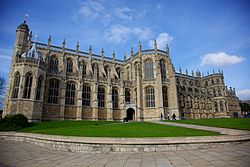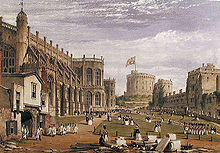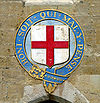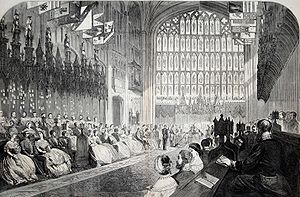- St George's Chapel, Windsor Castle
-
"St George's Chapel" redirects here. For the Episcopal church in Delaware, United States, see St. George's Chapel, Indian River.
St George's Chapel, Windsor Castle The Queen's Free Chapel of the College of St. George, Windsor Castle 
51°29′02″N 0°36′24″W / 51.48376°N 0.60678°WCoordinates: 51°29′02″N 0°36′24″W / 51.48376°N 0.60678°W Location Windsor Country United Kingdom Denomination Church of England Churchmanship High Church Website www.stgeorges-windsor.org History Dedication St. George Architecture Style Gothic Administration Diocese Royal Peculiar Clergy Dean David Conner Laity Organist/Director of music Timothy Byram-Wigfield St George's Chapel is the place of worship at Windsor Castle in England, United Kingdom. It is both a royal peculiar and the chapel of the Order of the Garter. The chapel is governed by the Dean and Canons of Windsor.
The chapel is located in the Lower Ward of the castle, which is one of the principal residences of Queen Elizabeth II.
The day to day running of the chapel is the responsibility of the religious College of St George, which is directed by a chapter of the dean and four canons, assisted by a clerk, virger (traditional spelling of verger) and other staffers. The Society of the Friends of St George's and Descendants of the Knights of the Garter, a registered charity, was established in 1931 to assist the College in maintaining the chapel.
Contents
History
In 1348, King Edward III founded two new religious colleges: St Stephen's at Westminster and St George's at Windsor. The new college at Windsor was attached to the Chapel of St Edward the Confessor which had been constructed by Henry III in the early thirteenth century. The chapel was then rededicated to the Blessed Virgin Mary, St Edward the Confessor and St George the Martyr. Edward III also built the Aerary Porch in 1353-1354. It was used as the entrance to the new college.
St George's Chapel became the Mother Church of the Order of the Garter, and a special service is still held in the chapel every June and is attended by the members of the order. Their heraldic banners hang above the upper stalls of the choir where they have a seat for life.
The period 1475-1528 saw a radical redevelopment of St George's Chapel, set in motion by Edward IV and continued by Henry VII and Henry VIII. The thirteenth century Chapel of St Edward the Confessor was expanded into a huge new Cathedral-like chapel under the supervision of Richard Beauchamp, Bishop of Salisbury, and the direction of the master mason Henry Janyns. The Horseshoe Cloister was constructed for the new community of 45 junior members: 16 vicars, a deacon gospeller, 13 lay clerks, 2 clerks epistoler and 13 choristers.
St George's Chapel was a popular destination for pilgrims during the late medieval period. The chapel was purported to contain several important relics: the bodies of John Schorne and Henry IV and a fragment of the True Cross held in a reliquary called the Cross of Gneth. These relics all appear to have been displayed at the east end of the south choir aisle.
The Chapel suffered a great deal of destruction during the English Civil War. Parliamentary forces broke into and plundered the chapel and treasury on 23 October 1642. Further pillaging occurred in 1643 when the fifteenth-century chapter house was destroyed, lead was stripped off the chapel roofs, and elements of Henry VIII's unfinished funeral monument were stolen. Following his execution in 1649, Charles I was buried in a small vault in the centre of the choir at St George's Chapel which also contained the coffins of Henry VIII and Jane Seymour. A programme of repair was undertaken at St George's Chapel following the Restoration of the monarchy.
The reign of Queen Victoria saw further changes made to the architecture of the chapel. The east end of the choir was reworked in devotion to Prince Albert; the Lady Chapel, which had been abandoned by Henry VII, was completed; a royal mausoleum was completed underneath the choir; and a set of steps were built at the west end of the chapel to create a ceremonial entrance to the building.
Garter Service
Members of the order meet at Windsor Castle every June for the annual Garter Service. After lunch in the State Apartments in the Upper Ward of the Castle they process on foot, wearing their robes and insignia, down to St George's Chapel where the service is held. If any new members have been admitted to the Order they are installed at the service. After the service, the members of the order return to the Upper Ward by carriage or car.
The order once enjoyed frequent services at the chapel, but, after becoming infrequent in the 18th century, were discontinued after 1805. The ceremony was revived in 1948 by King George VI for the 600th anniversary of the founding of the Order, and has since become an annual event.
Heraldry
After their installation, members are each assigned a stall in the chapel choir above which his or her heraldic devices are displayed.
A member's sword is placed below a helm which is decorated with a mantling and topped by a crest, coronet or crown. Above this, a member's heraldic banner is flown emblazoned with his or her arms. A much smaller piece of brass ("stall plate") is attached to the back of the stall displaying its member's name, arms and date of installation.
On a member's death, the sword, helm, mantling, crest, coronet or crown, and banner are removed. A ceremony marking the death of the late member must be held before the stall can be assigned to anyone else. This ceremony takes place in the chapel, during which the Military Knights of Windsor carry the banner of the deceased member and offer it to the Dean of Windsor, who places it on the altar.
The stall plates, however, are not removed; rather, they remain permanently affixed somewhere about the stall, so the stalls of the chapel are festooned with a colourful record of the members throughout history.
Chantries
St George's Windsor is among the most important and ambitious medieval chantry foundations to have survived in England. The college, itself a medieval chantry, also contains a number of independent chantries in the form of altars and small chapels dedicated to various members of the English monarchy and also to a number of prominent courtiers, deans and canons. Masses, the Office and prayers would be offered in these chantries for the good of the founder. Interestingly, Henry VIII had intended a chantry to be set up in the Chapel, despite the fact that he instituted the religious changes which brought about the Reformation in England and the eventual suppression of chantries.
The much admired iron gates in the sanctuary of the chapel as well as the locks on the doors of the chapel are the work of the Cornish metalsmith John Tresilian.[1]
The status of the college as a royal foundation saved it from dissolution at the Reformation. As a result, many of the smaller chantries within the chapel were preserved. These are the only remaining chantries of their kind in England which have never formally been suppressed.
Weddings
The chapel has been the site of many royal weddings, particularly of the children of Queen Victoria. These weddings include:
- The Prince Albert Edward, Prince of Wales and Princess Alexandra of Denmark in 1863 (later Edward VII and Queen Alexandra respectively)
- The Princess Helena and Prince Christian of Schleswig-Holstein-Sonderburg-Augustenburg in 1866
- The Princess Louise and the Marquess of Lorne (later Duke of Argyll) in 1871
- The Prince Arthur, Duke of Connaught and Princess Louise Margaret of Prussia in 1879
- Princess Frederica of Hanover and Luitbert von Pawel Rammingen in in 1880
- The Prince Leopold, Duke of Albany and Princess Helena of Waldeck-Pyrmont in 1882
- Princess Marie Louise of Schleswig-Holstein (daughter of Princess Christian) and Prince Aribert of Anhalt in 1891
- Princess Alice (daughter of the Duke of Albany) and Prince Alexander of Teck (later Earl of Athlone) in 1904
- Princess Margaret of Connaught (daughter of the Duke of Connaught) and Prince Gustaf Adolf of Sweden (later King Gustaf VI Adolf of Sweden) in 1905
- Lady Helena Cambridge (daughter of the Marquess of Cambridge, and niece of Queen Mary) and Major John Gibbs, Coldstream Guards in 1919 (non-royal)
- Anne Abel Smith (grand-daughter of Princess Alice, Countess of Athlone) and David Liddell-Grainger in 1957 (non-royal)
- Lady Helen Windsor (daughter of The Duke of Kent) and Timothy Taylor in 1992
- The Prince Edward, Earl of Wessex and Sophie Rhys-Jones in 1999
- Peter Phillips and Autumn Kelly in 2008
In addition to the above, the union of The Prince of Wales and Camilla Parker Bowles in 2005 received a blessing from The Archbishop of Canterbury.
Burials
The chapel has been the site of many royal funerals and interments. Royals interred here include:
Altar
- Edward IV, King of England, in 1483
- Henry VI, King of England (reburial), in 1484
- Elizabeth Woodville, Queen of England in 1492
- Edward VII, King of the United Kingdom, in 1910
- Alexandra of Denmark, Queen of the United Kingdom in 1925
Quire
- Jane Seymour, Queen of England, in 1537
- Henry VIII, King of England and Ireland, in 1547
- Charles I, King of England, Scotland and Ireland, in 1649
- Unnamed infant son of Henry VIII and Queen Anne Boleyn 1536
Royal Vault
- Princess Amelia of the United Kingdom in 1810
- Princess Augusta, Duchess of Brunswick-Wolfenbüttel, in 1813
- Princess Charlotte of Wales in 1817
- Charlotte of Mecklenburg-Strelitz, Queen of the United Kingdom, in 1818
- George III, King of the United Kingdom, in 1820
- Prince Edward, Duke of Kent and Strathearn, in 1820
- Princess Elizabeth of Clarence in 1821
- Prince Frederick, Duke of York and Albany, in 1827
- George IV, King of the United Kingdom, in 1830
- William IV, King of the United Kingdom in 1837
- Princess Augusta Sophia of the United Kingdom in 1840
- Adelaide of Saxe-Meiningen, Queen of the United Kingdom in 1849
- Prince Adolphus, Duke of Cambridge in 1850
- George V, King of Hanover, in 1878
- Princess Augusta of Hesse-Cassel in 1889
- Princess Mary Adelaide of Cambridge in 1897
- Francis, Duke of Teck in 1900
Near West Door
- George V, King of the United Kingdom, in 1936
- Mary of Teck, Queen of the United Kingdom in 1953
- George VI, King of the United Kingdom in 1952
- Princess Margaret, Countess of Snowdon (ashes) in 2002
- Elizabeth Bowes-Lyon, Queen of the United Kingdom, in 2002
Albert Memorial Chapel
- Prince Leopold, Duke of Albany, in 1884
- Prince Albert Victor, Duke of Clarence, in 1892
Other
See also
- Choir of St George's Chapel, Windsor Castle
- Dean of Windsor
- Dean and Canons of Windsor
- Francis Eginton, artist, painted the arms of the knights of the Garter for two Gothic windows in the stalls.
- List of Knights and Ladies of the Garter
- List of Ladies of the Garter
- Order of the Garter
- Saint George: Devotions, traditions and prayers
- The Society of the Friends of St George's and Descendants of the Knights of the Garter
- Windsor Castle
References
- Notes
- Sources
- Begent, P.J. and Chesshyre, H. The Most Noble Order of the Garter: 650 Years. Spink and Son Ltd. 1999, ISBN 1902040201
- Lawrence Keen and Eileen Scarff, ed. Windsor: Medieval Archaeology, Art and Architecture of the Thames Valley. Manley Publishing. 2002, ISBN 1902653459
- Nigel Saul, ed. St George's Chapel Windsor in the Fourteenth Century. The Boydell Press. 2005, ISBN 1843831171
- Eileen Scarff and Colin Richmond, ed. St George's Chapel, Windsor, in the Late Middle Ages. Windsor. 2001, ISBN 0953967611
- http://www.stgeorges-windsor.org/history/hist_index.asp
External links
Categories:- Tudor architecture
- Chapels in England
- Grade I listed churches
- Windsor Castle
- Royal Peculiars
- Collegiate churches in England
- Church of England churches in Berkshire
Wikimedia Foundation. 2010.




